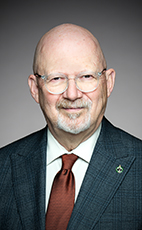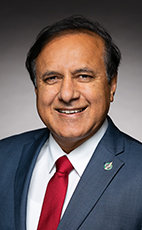44th Parl. 1st Sess.
May 18, 2023 10:00AM
- May/18/23 10:14:16 a.m.
- Watch
moved:
That, given that,
(i) Canada is in the midst of an opioid crisis that has killed over 35,000 people since 2016,
(ii) since 2017, the federal government has spent over $800 million on its failed Canadian Drugs and Substances Strategy, including over $100 million in funding for hard-drug supply projects across Canada, and plans to spend an additional $74 million to “scale up” these projects over the next five years,
(iii) since tax-funded drug supply was ramped up in 2020, opioid deaths have only gone up, according to the Public Health Agency of Canada,
(iv) in 2020, slightly less than 7,000 people died of opioid overdoses, while only 3,000 died of overdoses in 2016, according to the Library of Parliament,
(v) in British Columbia alone, yearly drug overdose deaths have increased by 330% between 2015 and 2022,
(vi) recently, a Global News reporter in East Vancouver was able to buy 26 hits for $30 in just 30 minutes of a dangerous and highly addictive opioid that is distributed in tax-funded drug supply programs and flooding our streets with cheap opioids,
the House call on the government to immediately reverse its deadly policies and redirect all funds from taxpayer-funded, hard drug programs to addiction, treatment and recovery programs.
He said: Mr. Speaker, I will be splitting my time with the hon. member for Cumberland—Colchester.
After eight years of the Prime Minister, everything feels broken. Life costs more. Work does not pay. Housing costs have doubled. The Prime Minister divides to control the people. Worst of all, crime and chaos, drugs and disorder rage in our streets. Nowhere is this worse than in the opioid overdose crisis, which has expanded so dramatically in the last several years.
The Prime Minister has a theory, backed up by a group of activists, most of them tax-funded, pharmaceutical companies and others that stand to gain from perpetuating the crisis. The theory is that, if the government provides powerful, heroin-like drugs that are uncontaminated, addicts will no longer use more deadly fentanyl, they will practise safe drug use and we will no longer have overdoses.
The Prime Minister has spent $78 million on 28 projects giving out free drugs. His recent budget proposes another $100 million for more tax-funded drugs. This includes heroin dispensary machines, where people can walk up, press some buttons and heroin pops out. It also includes prescriptions that allow people to take hydromorphone out into the street and use it or sell it, however they like. The theory is that this would divert away from more dangerous fentanyl. Let us look at the facts.
This is fact number one: Since the Prime Minister took office, there have been more than 34,000 apparent opioid overdose deaths. Here is another fact: This is not a problem the Prime Minister inherited; it is one he helped create. A total of 5,360 apparent opioid overdose deaths occurred from January to September 2022. This is approximately 20 deaths per day. It is a 173% increase from 2016, the first full calendar year he was in office. In other words, since his policies have come into effect, the overdose numbers have nearly tripled.
This is fact number three: While the deaths have risen across the country under the Prime Minister's policies, they have been the very worst in those provincial and municipal jurisdictions that have most enthusiastically embraced them. For example, in British Columbia, where in most jurisdictions, particularly Vancouver, all three levels of government have endorsed the so-called safe supply and decriminalization of hard drugs, the levels of overdose deaths have been the highest. Across B.C., the number of overdose deaths is up 330%.
The COVID excuse no longer works. This is a fact: Despite the claim, by supporters of handing out and decriminalizing drugs, that COVID was to blame for the crisis, what we have seen is that, as COVID moves farther away in the rearview mirror, the overdose deaths actually increase. For example, in March of this year, we had 9% more overdose deaths in B.C. than in March 2022, and 23% more overdose deaths than in March 2021. The more we move away from COVID, the more the overdose deaths increase. In fact, the deaths are not coinciding with COVID. They are coinciding with the recent decriminalization of crack, heroin, fentanyl and other hard drugs on January 1.
We are told that all the experts agree, just like the Liberals tell us all the time whenever they do something that defies common sense. We remember that all the experts agreed that printing money would not cause inflation, right before it led to a 40-year high, or that catch-and-release bail would not increase crime rates, before crime skyrocketed 32%.
We are told that giving out and decriminalizing hard drugs would reduce drug overdoses. These so-called experts are typically pie-in-the-sky theorists with no experience getting people off drugs, or they are members of the “misery industry”, those paid activists and public health bureaucrats whose jobs depend on the crisis continuing.
The real academic scholarship is clear, if the minister would even bother to read it. A thorough study by dozens of doctors and researchers from Stanford University, published in The Lancet and shared by a former adviser to President Obama, found that:
At the same time, evidence clearly shows the folly of assuming that population health inherently improves when health-care systems provide as many opioids as possible with as few possible regulatory constraints as possible. Policies that should attract scepticism include dispensing of hydromorphone from vending machines and prescribing a range of potent opioids and other drugs (eg., benzodiazepines, stimulants) to individuals with OUD in hopes of creating a safe addictive-drug supply and eliminating the supervision of methadone patients—ie, converting the system to unmonitored, long-term prescriptions on a take-home basis.
The study goes on to comment on the claim that hydromorphone, which is what the government is giving out, is safe. It continues:
Although expressed from a public health viewpoint, these messages echo the opioid manufacturers in presuming that unrestricted opioid provision can only improve public health. The faith of some advocates that opioids are safe as long as they are not derived from illicit markets is impossible to reconcile with the hundreds of thousands of overdose deaths from legal, pharmaceutical grade opioids that preceded the introduction of fentanyl into U.S. and Canadian heroin markets.
Furthermore, the safe supply program uses hydromorphone, which, according to one study published in a pharmacology journal, “produced similar subjective and physiological effects as heroin, but was more potent than heroin.” This is the stuff the minister and the Prime Minister are giving out using our tax dollars.
In a 2020 podcast, Dr. Mark Tyndall, one of Canada's earliest safer supply advocates, said that he had tested the urine of 15 patients who were on safer supply and found that 90% of them used fentanyl. In other words, they were not being diverted from fentanyl; they were using it in conjunction with safer supply. Now we know that it is even worse than that; the hydromorphone is being resold by the user to children, and the profit is being reinvested in buying fentanyl. In other words, the government is not only giving out dangerous hydromorphone but also actually, in effect, giving out fentanyl by giving the user the hydromorphone to sell to raise the revenue to buy fentanyl. The government is using our tax dollars to give out fentanyl on our streets and cause this crisis. Meanwhile, the cost of a hit of hydromorphone has dropped by between 70% and 95%, to roughly a dollar a hit, because the government is effectively paying for it and handing it out far and wide.
This makes no sense. The facts and evidence disprove it as a strategy. This is a radical and out-of-touch approach, which is not aligned with that of any other successful jurisdiction in the world. It is quite the opposite of what is being done in places like Portugal, which has focused on recovery, not on handing out free hard drugs. Therein lies the hope. We can turn the hurt the Prime Minister has caused into the hope Canadians need.
In Alberta, which is thoroughly rejecting the decriminalization and tax-funded handout of hard drugs and instead putting the money into recovery, we have seen, in the most recent data, a 30% reduction in the number of overdose deaths. That is because it is clear that what people suffering from addiction need is help getting off the drugs. To have that, we need recovery communities where they can go to get help with breaking the addiction and, if necessary, be given a bit of medication to relieve the side effects of getting off the drug, and then have the psychotherapy necessary to overcome the underlying reasons they got into drug addiction in the first place. We know this works. The evidence backs it up.
Therefore, our common-sense plan is to take the money away from subsidizing heroin-like drugs, and instead put all that money into recovery and treatment and sue the powerful pharmaceutical companies that helped cause this crisis, so we can use the proceeds of that lawsuit to fund even more recovery. That is how we are going to bring home our loved ones drug-free. It is how we will turn hurt into hope. It is the common sense of the common people, united for our common home: their home, my home, our home. Let us bring it home.
1625 words
- Hear!
- Rabble!
- add
- star_border
- share
- May/18/23 10:24:42 a.m.
- Watch
Mr. Speaker, I have been wanting to ask the Leader of the Opposition this question: Seeing that 46,000 overdoses have been reversed in the safe consumption sites, what would the Leader of the Opposition do in defunding them? How would he speak to those who have lost a loved one because their overdose was not reversed?
57 words
- Hear!
- Rabble!
- add
- star_border
- share
- May/18/23 10:25:12 a.m.
- Watch
Mr. Speaker, what I would say to anybody who has lost a loved one, including a daughter or a son, to drug overdose is that our heart goes out to them and that we are going to fix the problem the government caused, which led to that overdose in the first place.
The minister is quite right when she heckles that these people have died. They have died under her watch. They have died under the Prime Minister's watch, as he has flooded the streets with powerful heroin-like drugs, which have been paid for with tax dollars, have funded a black market for fentanyl, and have killed so many people.
It is not enough for us just to point out that the Prime Minister's policies have led to these deaths. Conservatives are going to turn the hurt that he has caused into the hope Canadians need. My message to those parents is that their child did not die in vain. We will make sure that other people's children get the recovery that would have saved lives if that recovery, treatment and rehabilitation had been in place. Hope is possible and hope is on the way.
199 words
- Hear!
- Rabble!
- add
- star_border
- share
- May/18/23 10:29:13 a.m.
- Watch
Yes, there will be a free vote, Mr. Speaker.
More than just going back to my own riding and community, I have been to the member's community. When I got off the plane on Vancouver Island, I found that the people in his riding and across the island are disgusted with the member's policies and with the policies that he has embraced, both provincially and federally. I got off the plane and, first thing, the pilot told me that he had two addicts in his backyard the night before, rummaging around and trying to steal so that they could pay for their drugs. Then, I saw the front page of the local Nanaimo newspaper, saying there are record overdoses. Then, one of the people who were going to be at my rallies was in the hospital because he was attacked by some members of the local tent city.
We have seen a massive overdose crisis because of the policies that the member has embraced, both provincially with the NDP and federally with the current Liberal government. We, as Conservatives, are the only ones who would fix it by going away from legal and free drugs towards recovery to bring our loved ones home, drug-free.
207 words
- Hear!
- Rabble!
- add
- star_border
- share
- May/18/23 10:46:21 a.m.
- Watch
Mr. Speaker, I will be sharing my time with the member for Sherbrooke.
Before I begin my speech, I want to acknowledge that I am rising today in Ottawa, which is on the traditional unceded territory of the Algonquin Anishinabe people, who have lived on this land since time immemorial.
It is important that we take the time today to address this national public health crisis, but first, however, I want to talk about the wording of the motion we are debating today.
The opposition is calling on us to reverse deadly policies, yet the BC Coroners Service has repeatedly said that there is no indication that the prescribed safe supply is contributing to the drug deaths from the illicit drug supply. It seems that the Conservative Party wants to take us back to the failed ideology of the Harper-era drug policies. Assez, c'est assez.
Why can the opposition members not understand the harm that their narrative is causing. The member talks about zombies and talks about crazy policies. This is stigmatizing, and that is all they know how to do. Do they not hear the public outcry from people who actually have lived and living experiences with substance use, the people who have overdosed two and three times and have been revived at a safe consumption site and are now part of helping people get well?
Groups like Moms Stop the Harm, who have are the loved ones of people who have lost lives to overdoses and toxic drug supply, have asked the Leader of the Opposition to meet with them in early June. Will he meet with them and hear their story? It changes people's lives and their opinions.
This fight against evidence-based programs that are actually saving lives just has to stop. People are dying but not for the reasons they are giving.
Canada is facing a twofold epidemic: a toxic and illegal drug supply and an overdose crisis.
Every day, countless lives are shattered by the devastating consequences of the crisis and over 30,000 people have died.
We must recognize that substance use and addiction are two complex problems that we cannot resolve by simply ignoring them or using outdated approaches.
Families mourn the loss of their loved ones. Communities bear witness to the tragedy of addiction, and the individuals suffer often in silence because they are being stigmatized, as the opposition is doing today. It does not have to be this way. Substance use disorder, opiate use disorder, is a recognized, chronic medical condition that deserves the same respect and evidence-based care as any other illness.
By implementing safer drug supply initiatives, we can save lives and provide individuals with the opportunity to break free from the cycles of addiction, because there is no recovery for people who are dead.
We have to be there. When the person using drugs asks “where is the suboxone lady”, we need that absolutely real-time approach.
It is by implementing safer supply that we minimize the risks of people using drugs. We can ensure that those who use drugs have access to pharmaceutical-grade substances that are tested for potency, purity and prominence. It is the poisoned drug supply that is killing people. The opposition needs to understand that this is the problem we are dealing with, this toxic drug supply.
We can prevent accidental overdoses caused by drugs with unpredictable potency, contaminated substances or adulterants.
We can save lives; we must save lives. However, our approach goes beyond saving lives. It is about creating the path to recovery and rebuilding shattered lives and families.
When individuals have access to safer drugs, they engage with the health care professionals. They are able to seek support, healing and rehabilitation. It is like moving from Insite to Onsite in Vancouver. It provides an opportunity for connection, trust and the delivery of comprehensive care.
I want to be clear that this is not about encouraging drug use or turning a blind eye to the consequences. It is about acknowledging the reality that people will continue to use drugs and that by providing a safer alternative, we can minimize the harm and pave the way toward recovery and rehabilitation.
Illegal drugs being sold illegally is still illegal. Diversion is illegal.
We need to recognize that, behind the statistics and the headlines, there are real people who have dreams but are struggling. They deserve our empathy, our understanding and our support. Stigmatizing people who are battling a substance use problem and criticizing the care they receive will not help them seek treatment.
What is more, Canadian drug policy and international drug policy are aligned. Prevention, harm reduction, treatment and enforcement make up the four internationally recognized pillars of drug policy.
We lived through 10 years of that Conservative government taking harm reduction out with its deadly war on drugs, and that has been proven to be ineffective, costly and deadly. These policies have also had a profound negative effect on Canada's most vulnerable, including indigenous people, children, young people, people living with disability, and immigrants and refugees.
While the Conservatives continue to try to take us back to the days when substance users were told that their lives did not matter, our government is using every tool at its disposal to put an end to this national public health crisis.
I would like to quote from the public safety and justice adviser to former prime minister Stephen Harper, Ben Perrin, who said, “Safer supply has been tested and found to be beneficial for people who have been unable to have treatment for whatever reason, and are long-term substance-abuse users. We’re talking about essentially substituting a contaminated street drug with a drug that has known contents and potency to help people stay alive, first of all, and also to be able to stabilize.”
Here is what some other important experts have said. Both the College of Physicians and Surgeons of BC and the College of Physicians and Surgeons of Ontario have made statements acknowledging safer supply is a harm reduction tool to support people with opioid use disorder.
I encourage the member to reread the CMAJ article from last September and see that on safe supply, the community health centre is providing the suite of health and social services reports. That is exactly what we do. It is exactly how we get them in the door so they can find a way to a better life.
As I continue to say, since 2017, safe consumption sites in Canada have received more than 4.1 million visits, reversed 46,000 overdoses and made 236,000 referrals to health and social services, which the Conservatives have vowed to defund.
What do we say to the families of those who would have died if this approach had not been offered to people who use drugs? If only I could say that this is the first time the Conservatives have not followed public health advice.
Unfortunately, this is the pattern for the official opposition. Despite overwhelming support and effectiveness of vaccines and despite the fact that 11% of maternal deaths are from unsafe abortions, that party continues to prefer ideology over evidence. We, as a country, must and can do better. I prefer the Canadian Medical Association Journal to the National Post. More important, this is how we will save lives.
1238 words
- Hear!
- Rabble!
- add
- star_border
- share
- May/18/23 11:02:44 a.m.
- Watch
Mr. Speaker, I am pleased to rise in the House today to address the motion from the member for Carleton and provide an update on our government's response to a complex challenge facing our country, the overdose crisis. This crisis is having a tragic and unrelenting toll on Canadians, their families and communities.
Each one of these deaths is tragic and creates a void in the community that can never be filled. Every person who has lost their life in this crisis has left behind someone who is grieving: a friend, a partner, a parent or a child.
There are four pillars recognized internationally as necessary for a successful substance use strategy: prevention, harm reduction, treatment and enforcement. Our government is committed to a comprehensive approach that implements policies and supports for all four of these essential areas.
The dangerous, ideological and outdated approach proposed by the Conservative motion creates a false choice between harm reduction measures and treatment. We need both. As B.C. chief coroner Lisa Lapointe recently said, “There should not be a dichotomy between access to life-saving safer supply and access to life-saving treatment options”.
The intent of this motion is simply to create fear, increase stigmatization and score political points with the Conservative base. It is dangerous, anti‑science and would cost lives if implemented.
The toxic drug supply and overdose crisis is a daily worry for our government. When we think of the lives lost, the repercussions for communities, the devastating losses for families and the impact on the economy, we realize that it is a national tragedy.
It has never been more important for all levels of government, partners and stakeholders to work together to turn this crisis around.
To find solutions, we must first understand the many different factors that drive substance use. That must include addressing mental health. Harmful patterns of substance use are established over time. Some people can trace their substance use back to early childhood trauma. Others may be affected by poverty or housing instability.
While many people in Canada struggle with mental health problems, some groups face particular challenges because of systemic racism, discrimination, socio-economic status or social exclusion.
Marginalized groups are often victims of stigmatization or prejudice, which places them at higher risk. These include youth, indigenous peoples, racialized communities and LGBTQ+ people.
Stigma is harmful in several ways.
Stigma discourages people from seeking help and reduces their chances of getting help when they do seek it. It can also make it difficult to get the support needed to implement policies and programs to help people who use substances.
That is because there is still a deep-seated misconception that addiction is a choice, and that is just not true.
Addiction is a medical condition that can be treated.
The fact is that people who use substances need support, not judgment. They need community, not isolation. They need empathy and understanding, not stigma. When substance use is stigmatized, it creates a very dangerous situation. It can lead to people using drugs alone and prevent them from seeking help. That is why we need to provide a continuum of care to people who use substances, one that is woven through every area of their lives. Prevention, treatment and harm reduction measures all have a role to play, as too do actions that reduce stigma and provide continued access to health and social supports for individuals.
Our goal is to reduce the stigma and risks associated with substance use while providing people who use drugs with better access to health and social services.
To achieve this, Canada must address the risks of substance use from a comprehensive societal perspective.
Since 2017, the government has invested more than $1 billion in prevention, treatment, risk reduction and enforcement. This is in addition to the investments made by provincial governments within their jurisdictions.
The Government of Canada is now working with the provinces and territories on a transformative multidisciplinary care model that integrates patient centred mental health and substance use care.
From increased access to mental and substance use health through primary care to improve data and better sharing of health information between the professionals they consult, these tailor-made agreements with provinces and territories would improve access to the supports Canadians need when they need it.
However, we know that we need to do more, and that includes trying innovative approaches in order to save lives. It also includes making it easier for people who use drugs to access health and social services, such as treatment for people who are ready for it.
Budget 2023 sets out our plan to transfer nearly $200 billion to the provinces and territories over the next few years to improve health care, including support for mental health and substance use services. This will be done through a combination of increases to the Canada health transfer and new 10-year agreements with the provinces and territories.
These investments would help us build, among other things, a resilient health workforce that provides Canadians with high-quality, effective and safe health services when they need them. That includes access to timely, equitable and quality mental health, substance use and addiction services.
Through our tailored bilateral agreements, we will invest $25 billion over 10 years to work with the provinces and territories to advance shared health priorities.
This approach is the most effective way to integrate mental health and substance use services throughout the health care system.
This investment is in addition to the $2.4 billion over the next four years that will still be provided to the provinces and territories for mental health and addiction services as part of the 2017 common statement of principle on shared health priorities.
Harm reduction services are a vital part of a comprehensive, compassionate and collaborative public health approach to problematic substance use that includes prevention, treatment and additional social and health supports.
We cannot allow the Conservative Party's ideological agenda to shut down the safe consumption sites that have prevented more than 46,000 overdoses since 2017.
Safe consumption sites replace contaminated street drugs with a drug of known content and potency to keep people alive.
We need to keep people alive until they are ready to access treatment. We cannot allow the Conservatives to take us back to the failed ideology of the past.
Together, we can create real systemic change and give every person in Canada the support they need to live long and healthy lives.
1093 words
- Hear!
- Rabble!
- add
- star_border
- share
- May/18/23 11:12:01 a.m.
- Watch
Mr. Speaker, my thoughts are with the people in his riding.
There are several ways to help drug users, and if we want to keep people safe, supervised consumption sites and overdose prevention sites are part of the solution. They play a significant role in saving lives. Almost no one has died of illicit drug poisoning at these sites. We are there, and we will move forward with the opening of others.
72 words
- Hear!
- Rabble!
- add
- star_border
- share
- May/18/23 12:27:02 p.m.
- Watch
Madam Speaker, it seems there is conflation of a lot of issues, when I hear the member opposite speak. I was looking at a study from U of T about safe consumption sites, and it says that there was a city-wide overdose mortality reduction of 42% between the time when we started, before we had safe consumption sites, and now. Not only that, but in neighbourhoods that are 500 metres around a safe consumption site, the overdose mortality rate decreased by 67%. In the Canadian Medical Association Journal, there was also a study from London, Ontario, that showed that mortality decreased with safe supply.
While I am not denying that there is, in fact, an opioid crisis and that there are fentanyl deaths, does the member opposite not agree that there is medical evidence that safe supply is actually saving lives?
142 words
- Hear!
- Rabble!
- add
- star_border
- share
- May/18/23 12:31:50 p.m.
- Watch
Madam Speaker, this is about facts and statistics, and the very sad fact is that opioid deaths have been going up, especially after the government started this program of so-called safe supply. Just in B.C. alone, there has been a 330% increase in overdose deaths. Those are the facts. That is why we need to change the system. It is not working. The government's plan does not work. We need a better plan. A Conservative plan would focus on treatment and compassionate care.
86 words
- Hear!
- Rabble!
- add
- star_border
- share
- May/18/23 12:42:44 p.m.
- Watch
Madam Speaker, again, the statistics speak for themselves. Overdoses are up 300%; that is just the reality of it.
I really want to touch on a critical point, and that is the fear that has been instilled in experts who are on the ground. I am going to read something from somebody who has worked for three decades in treatment and recovery. This person, for the record, is not a Conservative.
This person says, “I have to agree with the leader 100%... But for people speaking out against it, you become vilified, like we don't care about people. Hydromorphone doesn't even come close to the strength of fentanyl. I had one young fellow tell me, if someone dies from an overdose, people are trying to find out who the dealer is so they can purchase from them because of the strength. We are just throwing—
149 words
- Hear!
- Rabble!
- add
- star_border
- share
- May/18/23 12:46:49 p.m.
- Watch
Madam Speaker, I will be splitting my time with the member for Winnipeg North.
I am grateful for this opportunity to speak today to discuss the ongoing toxic drug overdose crisis. While I do that, my thoughts are on the many people we have lost in London, Ontario, a lot of friends and family, to this overdose crisis, which continues to exact a heartbreaking toll on individuals, families and communities across the country.
As the representative for London West and the former municipal representative for the downtown core of London, I have had the opportunity to see first-hand the hard work and dedication that our frontline workers have put into saving lives and improving outcomes for Londoners experiencing addiction.
I want to take this opportunity to thank them and to thank the Middlesex-London Health Unit, the Regional HIV/AIDS, the London InterCommunity Health Centre and anyone else who has dedicated their time, our volunteers, to helping the most vulnerable people experiencing this disease that has put them through unimaginable situations.
This dual pandemic has impacted people from all walks of life, ages, education levels and party lines, including many of us in the House today. We can no longer say that it is a stranger or that it is happening over there, because it is happening in all our communities. We are talking about our children, our friends, our parents and our neighbours, which is why I cannot understate the importance of a compassionate, collaborative and integrated response to reducing substance harms and saving lives.
Since 2016, Dr. Andrea Sereda of the London InterCommunity Health Centre has been running a safer supply program that has saved countless lives. Thank God, she is doing this work as an experienced doctor. We are not taking opinions from op-eds or online news; we are actually looking at studies that have been conducted by experts in the field. However, the program received federal funding in March of 2020.
Between April 1, 2020 and March 31, 2021, overdoses in the area dropped from 59% to 23%, 44% of the clients had not committed a crime to pay for drugs since beginning the program and one third of clients stopped using IV drugs. This is only one small piece of the empirical evidence that a safer supply actually works.
Prevention, harm reduction, treatment and enforcement make up the four internationally-recognized pillars of drug policy. Sadly, the Conservative Party does not understand the importance of the harm reduction pillar, preferring instead to ignore hard evidence and research, and is taking us back to the failed ideology of the Harper-era drug policy, which was costly, ineffective and deadly.
We are hearing from experts themselves, especially in communities like London, Ontario, where we know that a safer supply is working, that we need to continue to explore all avenues to address this ongoing crisis.
Our government, on the other hand, is committed to responding to this crisis from a whole-of-system and evidence-based approach. To date, we have launched many actions and investments to address the overdose crisis, including increased naloxone access, increased options for opioid agonist treatment, supervised consumption sites, which we have in the community of London, Ontario, and safer supply programs, whose importance, sadly, continues to be negated by the opposition.
An integral part of our response is ensuring that we have the best research evidence to inform our health policies and practices, and ultimately lead to better health and safety outcomes for all Canadians. This is where the incredible work of the Canadian Institutes of Health Research, or CIHR, comes in.
Over the last five years, CIHR has invested more than $179 million in research related to substance use, including $75 million in research related to opioid use alone. With its help, our government is supporting priority research initiatives that are now helping policy-makers and health care providers identify effective solutions for addressing the overdose crisis.
I want to begin by highlighting a pan-Canadian research network that is focused on substance use, the Canadian Research Initiative in Substance Misuse, or CRISM, which connects researchers, service providers, decision-makers and people with lived experience of substance use from across Canada.
CRISM's overall objective is to translate evidence-based interventions for substance use into clinical practice, community-based prevention, harm reduction and health system changes. The network is now recognized as a critical network that responds to the policy and evidence needs of decision-makers.
With ongoing support from the federal government, CRISM is able to conduct clinical trials, develop national treatment guidelines, promote the effective implementation of evidence-based interventions into clinical and community settings, and provide key evidence for decision-makers, like ourselves.
In June 2022, our government announced that it would be renewing CRISM with an investment of $17 million over six years to build and expand on the success of the initiative’s first phase, including by increasing the number of regional nodes from four to five to enhance geographic coverage.
This renewed investment also includes $5 million over four years for CRISM to undertake a national controlled trial in the management of methamphetamine-use disorder. The expertise and guidance that CRISM provides is integral to improving the quality of care and quality of life for people in Canada who use substances.
Outside of this investment, in 2019, CIHR also invested $1.5 million to support the evaluation of interventions implemented across Canada in response to the opioid crisis. This included evaluation of overdose prevention sites, rapid access addiction medicine models of care and naloxone programs, just to name a few. It also included research to evaluate non-pharmacological interventions for pain management.
Research to address the toxic drug and overdose crisis became even more critical during COVID-19, which exacerbated the existing crisis to a devastating extent. As part of the pandemic response, our government committed to, through CIHR, launching a funding opportunity in 2019 to support the evaluation research into harm-reduction approaches and to address the opioid crisis in the context of COVID-19. We know that this has grown since COVID-19.
This funding opportunity provided $2.2 million to support five research projects to assess the implementation and impact of safer supply interventions and supervised consumption sites, thereby addressing pressing evidence needs of decision-makers and knowledge-users in the area of harm reduction.
Additionally, CIHR mobilized CRISM to rapidly develop six national guidance documents to support people who used drugs, decision-makers and care providers during COVID-19, for example, guidance on telemedicine support for addiction services. We are also prioritizing bold policy changes to help people who use substances on their journey.
Last year, our government announced a time-limited exemption from the Controlled Drugs and Substances Act to the province of British Columbia, allowing for the personal possession of small amounts of certain illegal substances. Through this exemption, we will be able to reduce the stigma, the fear and the shame that keeps people who use drugs silent about their use, or using alone, and help more people access life-saving support and treatment.
Notably, the exemption included requirements related to comprehensive monitoring and evaluation. In addition to efforts led by B.C., our government is supporting an arms-length evaluation of this exemption.
This five-year evaluation project, led by CRISM, will study the impacts of the exemption and help us understand the full impacts of decriminalization in B.C., including the health and socio-economic impacts. This scientific evidence will be critical to ongoing decision-making as it relates to the overdose crisis.
We are also supporting critical research through CIHR’s investigator-led programs, which supports world-class research submitted by scientists at universities and research institutions across the country.
In addition to supporting the translation of research into improved programs and policies related to substance-use treatment and prevention, we will also be supporting research focused on improving health human resources related to substance use.
For example, CIHR is currently funding a project led by Dr. Kathleen Leslie and Dr. Mary Bartram at Athabasca University that will provide better information about policy options and stakeholder priorities to help create a pan-Canadian mental health and substance-use workforce strategy. This strategy will support the development of a high-quality, sustainable, diverse and culturally competent workforce that will have the capacity to provide equitable access to mental health and substance-use services for all Canadians.
1415 words
- Hear!
- Rabble!
- add
- star_border
- share
- May/18/23 2:09:19 p.m.
- Watch
Mr. Speaker, after eight years under this Prime Minister, everything feels broken. Life is more expensive, work does not pay and housing costs have doubled. The Prime Minister devised a way to control the people. Worst of all, crime, chaos, drugs and disorder rage in our streets. Nowhere is this worse than in the opioid overdose crisis that has expanded so dramatically in the last several years.
When I walk outside in Maple Ridge's downtown core, more often than not, I see men and women strung out on drugs. It is tragic and heartbreaking, and it is the same in cities across B.C. Needles are everywhere, and thousands are dying. In B.C. alone, yearly overdose deaths have spiked 300% since the Liberals came into power.
The Liberal-NDP solution is to have more free drugs and death. Why does the government cling so stubbornly to its failed drug policies—
153 words
- Hear!
- Rabble!
- add
- star_border
- share
- May/18/23 2:25:01 p.m.
- Watch
Mr. Speaker, emissions only went down when the government actually locked down the country for COVID, if it wants to do that forever.
The Prime Minister decriminalized crack, heroin and other hard drugs on January 31. He has flooded the streets with taxpayer-funded hydromorphone, and today we have learned the tragic results. The report from British Columbia shows that seven people are dying every day of overdoses. In April, overdose rates were up 17%.
This experiment has failed. When will the Prime Minister get common sense, get drugs off our streets and get our people into treatment?
98 words
- Hear!
- Rabble!
- add
- star_border
- share
- May/18/23 3:59:29 p.m.
- Watch
Madam Speaker, I rise in this chamber today to speak on this motion.
In my riding, the community of Richmond Centre, I have heard of many heartbreaking incidents. Michael, an artist, an empath and a gentle, compassionate young individual passed away at age 26 from a tainted supply of drugs. Curtis was an intelligent, caring and adventurous person. He was 36 when he passed away from drug overdoses and poisonings. Countless incidents like these happen in British Columbia and across Canada. It breaks my heart to see mothers, fathers, friends and families lose their dearly loved ones.
Last year, in Richmond, 29 people died of drug poisoning, and 2,314 died in British Columbia. On CBC news today, it said that in British Columbia 206 people were suspected to have died of toxic drugs in April alone this year.
Let us talk about the link between mental health and substance use. We know that mental health and substance use is affecting more and more Canadians and requires collaboration across all levels of government as well as with other partners in our community. It is for that reason that, in 2021, Canada’s first-ever ministry of mental health and addictions was created, and showed the interconnected nature of mental health with substance use.
It has also highlighted our government’s commitment to take action through an integrated approach on these issues that have significantly impacted individuals, their families and communities. It is important to stress that mental illness and substance use often go hand in hand. People with mental illnesses are twice as likely to have a substance use disorder compared to the general population.
Substance use can also increase the underlying risk of mental health issues and can exacerbate the symptoms of existing mental health issues. In fact, 50% of people in treatment for substance use also live with mental illness. We know that childhood trauma, low income, lack of access to stable housing, discrimination, racism, and the historical and ongoing effects of colonization and the residential school system on indigenous communities all play a major factor.
There are many challenges faced by Canadians experiencing mental illness and harms from substance use. These include a lack of available services and supports close to home, care that is not comprehensive or responsive to an individual’s needs, and the experience of stigma and discrimination, both in seeking care and in society.
Youth and young adults, indigenous peoples, Black Canadians and those identifying as LGBTQ2S+ are among those Canadians impacted the most. As a result of unmet or under-addressed mental health and substance use needs, individuals and communities face significant health, social and economic burdens. This includes paying out of pocket for services, increased emergency department visits and public safety concerns.
Our government has long recognized that Canadians with mental health and substance use needs require ongoing supports to meet a complexity of needs. We have seen the record of the Conservatives on this issue. They stand up in the chamber and use stigmatizing language to try and play politics with this issue, and act like they are not misleading Canadians with a bias or one-sided perspective on this crisis.
Canadians have spoken of the complexity of these mental health and substance use issues, and how often they are interconnected with other social issues, such as homelessness.
For example, we know that up to 75% of women experiencing homelessness also experience mental illness. In British Columbia, 67% of people experiencing homelessness or housing instability identified substance use issues, and 51% identified mental health as a concern.
Accessing appropriate housing options that provide ready access to needed wraparound supports can be a significant challenge, due to housing shortages and maintenance issues with existing housing; insufficient community-based, trained provider capacity; and silos between health, housing and social sectors.
This is why our government is investing in affordable housing for Canadians, including $4 billion through the rapid housing initiative, aimed at quickly creating new affordable housing for individuals who have severe housing needs and are at risk of being homeless.
Ensuring Canadians have access to housing, social supports and the health services they need is a major preoccupation of municipal and community leaders. Our government is working with them, and with the provinces and territories, to break down silos, so Canadians can have access to the integrated supports they need.
We are also committed to working with indigenous governments and communities to support access to a comprehensive range of evidence-based, culturally appropriate and trauma-informed services and supports needed to support mental health and substance use issues that individuals are facing, including the opioid overdose crisis, and to advance whole-of-society approaches to these issues.
Through the mental wellness program, Indigenous Services Canada is providing supports for substance use prevention, harm reduction, treatment and aftercare, psychosocial wraparound services and trauma-informed health supports to indigenous communities. In addition, our government has provided targeted supports for innovative community-based projects that address mental health and substance use issues.
The opposition members will stand up and say that the government is not putting resources into treatment, but since 2017, we have invested more than $400 million in over 380 projects through the substance use and addictions program to support community-based organizations.
In 2018, our government committed $150 million over five years to address the opioid crisis through the emergency treatment fund, which also had funds cost-matched by provinces and territories: over $300 million in funding for substance use treatment across Canada.
This shows how much we are putting into treatments and how we should not be taking lessons from a party that wants to revert to Harper-era policies. Tackling the opioid overdose crisis requires a holistic and integrated approach that focuses on mental health and well-being. That is what this government has been doing, so that Canadians can be resilient and healthy now and into the future.
Enough is enough.
We will not be able to bring loved ones home if they are dead from toxic supplies. This is a fight that we must triumph. This is a non-partisan issue, and we will prevail with collaboration with provinces, territories, municipalities and local community organizations, such as, in my riding, the Richmond Addiction Services Society, Turning Point Recovery Society and Pathways Clubhouse.
I want to thank the Minister of Mental Health and Addictions for her continuous championship on this matter, and all the first responders, frontline workers and health care workers for all they do.
1091 words
- Hear!
- Rabble!
- add
- star_border
- share
- May/18/23 4:09:21 p.m.
- Watch
Madam Speaker, I would like to take a common-sense approach. Would anyone want their kids to access toxic drugs through a vending machine or want drugs to be accessible in the community, so that children have easy access to substances that are harmful to their health? I think our government is working very hard to create more programs to support the people in need in this overdose crisis.
69 words
- Hear!
- Rabble!
- add
- star_border
- share
- May/18/23 4:14:13 p.m.
- Watch
Madam Speaker, I will be splitting my time with the hon. member for Sherwood Park—Fort Saskatchewan.
Today, we are addressing the health of our nation. After eight years of the Prime Minister, everything feels broken, especially in my home province of British Columbia. Drugs, disorder and violent crime are all on the rise in our neighbourhoods. People are lining up at food banks in record numbers because they cannot afford groceries. Many cannot afford a home, and, worst of all, the opioid crisis is claiming the lives of our sons and daughters. Under the watch of the Prime Minister, there have been 34,000 opioid deaths, and that number is growing by the day. In B.C. alone, overdose deaths are up 330%, by far the worst rate of all the provinces.
The B.C. coroner released a report today, saying that 206 people died of overdose in April. That is 206 people, including one at a safe injection site, who died in one month. The report said that 70% of victims were between the ages of 30 and 59. People in that age bracket should be buying a home, having children and enjoying a successful career. Instead, in the Prime Minister's Canada, they are chasing their next hit. Why is that? It is because all three levels of government, including the federal Liberals, the provincial NDP, this NDP caucus and left-wing mayors and councils, have decriminalized illicit drugs, flooded the streets with so-called safe supply and failed to create the treatment and connection needed for people suffering with addictions to build a drug-free life.
Over 800 people have died in the first four months of this year. If overdose deaths continue at this pace, we could lose up to 2,400 British Columbians this year. Death by overdose cannot be normalized. Instead, we need treatment and recovery. These programs will help those struggling with addictions and we need them now.
The Liberal-NDP coalition is flooding our streets with drugs and supercharging this opioid crisis. One Global News reporter took to the streets of Vancouver to find out where all these safe supply drugs are going. The reporter was able to buy 26 hits of safe supply drugs for only $30, in just 30 minutes, in Vancouver's Downtown Eastside. Outreach workers in Vancouver's Downtown Eastside claim that the safe supply hydromorphone tablets can be bought for as little as 25¢ per pill on the streets. It is no wonder that the B.C. coroner reports that seven people per day are dying from drug overdoses in my province.
This heavy amount of free drugs on our streets perpetuates the addiction cycle, prolongs suffering and prevents recovery. It is leading to more deaths, not fewer. How many more Canadians must die before the Prime Minister learns that treatment, not free drugs, saves lives? We need to help get people off drugs so that they can effectively address their addiction issues, enjoy improved health, reconnect with family, get jobs and become contributing members of society.
Let us be clear. The government's radical agenda is fuelling the opioid crisis. It uses the term “safe supply” as though it were a medical term, but, in truth, that phrase is nothing more than marketing jargon used by big pharma. Let us speak the truth. There is nothing safe about safe supply.
The Liberal and NDP drug pushers point to other jurisdictions that have decriminalized hard drugs to justify their radical agenda. For example, they say that Portugal set the gold standard for decriminalization of illicit drugs, but they forgot to mention that Portugal ensured that treatment and recovery services were expanded before they changed the laws. They also omit that health outcomes in Portugal have worsened since that country decreased treatment services.
What is worse is that they are ignoring a made-in-Canada model that is saving lives in Alberta. That province has become a beacon of hope for how lives can be turned around, with professional, caring drug treatment services. I hear members clapping; it is worth clapping for. Overdose deaths are down in that jurisdiction by 30%, while B.C. overdose deaths continue to climb.
We know that merely providing safe supply drugs will never get people out of an addiction cycle. When Conservatives form government, we will follow Alberta's example by building world-class recovery communities and implementing similar services around the country to save lives.
We also need to consider the impact that the so-called safe supply program is having on our youth. On the streets of Vancouver, people living with addictions are selling these cheap drugs to kids. They then use the money to buy stronger, deadlier fentanyl. Impressionable youth are accessing this cheap, plentiful supply of highly addictive drugs as a gateway to harder, more dangerous substances. In plain terms, the safe supply program is a direct threat to the lives of our youth.
A report from the B.C. coroner confirmed that overdose victims are trending younger and that opioid addiction among B.C.'s youth is increasing. Speaking as a mother, I say that we cannot allow the government to ignore the evidence when our teenaged sons and daughters are lying face down on a sidewalk in a zombie-like state. Safe supply drugs are putting youth on the path to hard-core addictions, and this needs to stop. Too many parents have lost children to drug overdoses in this country.
The story of Jack Bodie, from Burnaby, is far too common. Jack was a productive and active 17-year-old boy who was deeply loved by his family. Tragically, Jack snorted half a pill laced with fentanyl. Inhaling the drug slowed down Jack's breathing and heartbeat, and within minutes, his entire system shut down and he passed away. Jack's death sent his family into deep and profound grief. His dad, now a treatment and recovery advocate, maintains that the real tragedy is that there are thousands of families across Canada dealing with the same grief that he faced over the death of a child due to a drug overdose.
Police constable David Steverding works in Vancouver's Downtown Eastside, and he is a member of the Odd Squad, a group of dedicated police officers who provide drug use prevention education to youth throughout Canada. The constable has worked with hundreds of people living with addiction, and with their families. He said that people often say using drugs is a personal choice and a victimless crime, but that these comments overlook the friends and family members, who, he notes, are often completely helpless, standing by and watching while the drug user spirals downhill.
To the families that have tragically lost sons and daughters to a drug overdose, my message is this: We will make sure their child did not die in vain. We will scrap the dangerous social experiment of safe supply and ensure other kids who struggle with addictions get the treatment they need so they can come home to their families drug-free. The consultants and big pharma that turbocharge opioid marketing will pay for it. We will hold them to account as government policy.
Recovery, treatment and rehabilitation are how we are going to bring home our loved ones. It is how we will turn hurt into hope. It is the common sense of the common people. Hope is possible, and hope is on the way.
1250 words
- Hear!
- Rabble!
- add
- star_border
- share
- May/18/23 4:59:59 p.m.
- Watch
Mr. Speaker, I would like to thank the hon. member for his very reasonable speech in response to the quite unreasonable motion before the House.
In doing so, I would like to ask if he agrees with me on this. On Vancouver Island, there are more than a dozen overdose prevention sites, which people like to call safe consumption sites. They save hundreds of lives every year, but they also help connect those with addiction problems to social services and treatment programs in the community.
Does he agree with me that the closure of those overdose prevention sites would contribute to more deaths and a larger number of addiction problems in the community?
113 words
- Hear!
- Rabble!
- add
- star_border
- share
- May/18/23 5:01:22 p.m.
- Watch
Mr. Speaker, this is a really important subject. The director of my constituency office just buried her nephew after his fentanyl overdose on the streets of Montreal. I do not think anyone in this House would disagree that the issue of overdoses and addictions is of great importance.
I would like to ask my hon. colleague if he would elaborate a bit more on how a safe supply is going to save people like the nephew of my constituency director.
80 words
- Hear!
- Rabble!
- add
- star_border
- share
- May/18/23 5:02:45 p.m.
- Watch
Mr. Speaker, as everyone sitting in this House knows, the toxic drug supply and overdose crisis is devastating communities throughout Canada. We are losing 20 Canadians a day. Prior to COVID, 10 people were fatally overdosing every day in Canada, but now it has increased. Many more of our friends, family members and community members are being hospitalized, calling emergency support for services and grieving lives lost over the past seven years of this crisis.
Unfortunately, we are now debating a misguided motion rooted in outdated ideology that will recycle a discredited, narrow approach rather than create a comprehensive plan to deal with a crisis that is killing people. Even former prime minister Stephen Harper's public safety adviser, Benjamin Perrin, has seen the light and describes the current Conservative approach, which is epitomized by this motion, as “rehashing Conservative, war-on-drugs tropes that have been long since discredited and have been found to be not only ineffective, but costly and deadly.”
There are four pillars recognized internationally that are necessary for a successful substance use strategy: prevention, treatment, enforcement and harm reduction, including a safer supply. In December 2016, our government launched the Canadian drugs and substances strategy, which uses a public health approach to substance use. In doing so, we committed to a comprehensive, collaborative, compassionate and evidence-based drug policy.
Under the Canadian drugs and substances strategy, the Government of Canada has taken evidence-based action to address the toxic drug supply and overdose crisis and has announced over $1 billion in funding. This funding includes $490 million through Health Canada's substance use and addictions program to support community-based treatment, harm reduction, prevention, and stigma reduction activities. In addition, this funding has supported research and surveillance initiatives and strengthened law enforcement capacity to address illegal drug production and trafficking. Going forward, the Canadian drugs and substances strategy will continue to guide our government's drug policy approach, which includes a full continuum of evidence-based options, as well as innovative life-saving strategies to meet people where they are and provide them with the supports they need.
Substance use is an extremely complex issue, and Canadians use drugs for a multitude of reasons. Not everyone who uses drugs is suffering from an addiction. Even when a diagnosis exists, treatment services may not be available or affordable. Moreover, not everyone is always willing, eligible or able to enter treatment. Recovery looks different for everyone. Services to keep people alive and safe and that support better health outcomes should not be limited to just treatment services for people with a formal diagnosis of a substance use disorder, given the crisis is affecting people trying drugs for the first time, people who use drugs occasionally and people who are struggling with an addiction in silence.
There is no one-size-fits-all solution to this crisis. We need a range of interventions that meet people where they are and reduce the potential harms related to substance use. Harm reduction is a key element of that work and this government's strategy to address the toxic drug supply and overdose crisis.
Evidence has shown us that harm reduction measures, such as supervised consumption sites, in-person or virtual spotting services, safer supply, take-home naloxone, and drug-checking technologies, are supporting people who use drugs by connecting them to health and social services and, most importantly, are keeping them alive. For example, in one of the hardest hit provinces, evidence in British Columbia has shown that the combined effect of expanded access to take-home naloxone programs, supervised consumption sites and opioid agonist treatment has been crucial to averting overdose deaths in the province. In addition, between 2015 and 2021, nearly 125,000 naloxone kits were used to reverse an overdose in B.C.
In 2016, there were only two supervised consumption sites in Canada, both in Vancouver. Since then, the number of federally approved supervised consumption sites offering services has grown to as high as 40, and they are available in British Columbia, Alberta, Saskatchewan, Ontario and Quebec. This is because we are investing in what works and where the evidence is. At these sites, more than 46,000 overdoses have been reversed, and there have been over four million visits. That is a point worth repeating.
The safe consumption sites the Conservative leader wants to shut down have reversed more than 46,000 overdoses since 2017. When we say that harm reduction meets people where they are, this is what we mean. These harm reduction services are saving lives every day. Spotting services support someone who is using drugs either in person or remotely by phone, video chat or an app, and they provide help in case an overdose occurs.
During the first 14 months of operations, the virtual national overdose response service monitored over 2,000 substance use events and responded to over 50 adverse events. These events required an emergency response and no fatalities were reported.
Although the Conservative opposition will tell us otherwise, harm reduction efforts are not antithetical to treatment. They are part of the continuum of care. They meet people where they are, and they can connect people with a spectrum of health and social supports.
877 words
- Hear!
- Rabble!
- add
- star_border
- share
- May/18/23 5:12:49 p.m.
- Watch
Mr. Speaker, during today's debate, the Liberals have been conflating safe supply and safe consumption sites. They are two separate policies. The reality is that the member for Brampton Centre said safe consumption sites saved 45,000 lives.
However, anyone who has spent some time on the Downtown Eastside or in the Fraser Health region in my community, which has even higher overdose death rates than Vancouver, knows that someone who has an overdose could receive good care from there, but that is not preventing them from accessing and using fentanyl and other illicit drugs in conjunction with the free drugs they are getting from safe supply providers.
If the policies the government is pushing so hard are good, why do the death rates continue to increase in my community? Why do the death rates across British Columbia continue to increase? Why have the death rates continued to increase since the government decriminalized fentanyl?
155 words
- Hear!
- Rabble!
- add
- star_border
- share
- menumenu
- notificationsnotifications
- home
- mailmail
- searchsearch
















